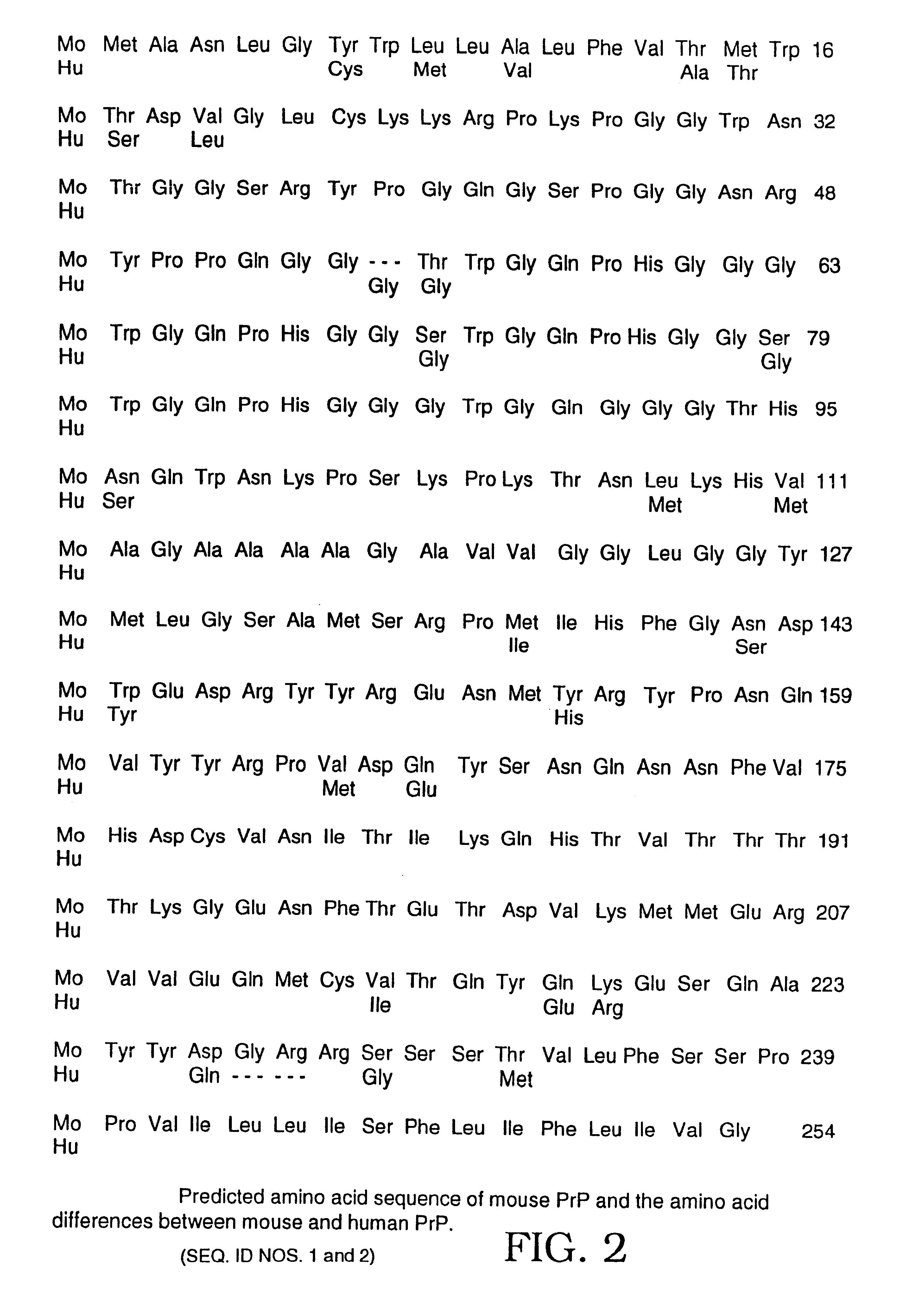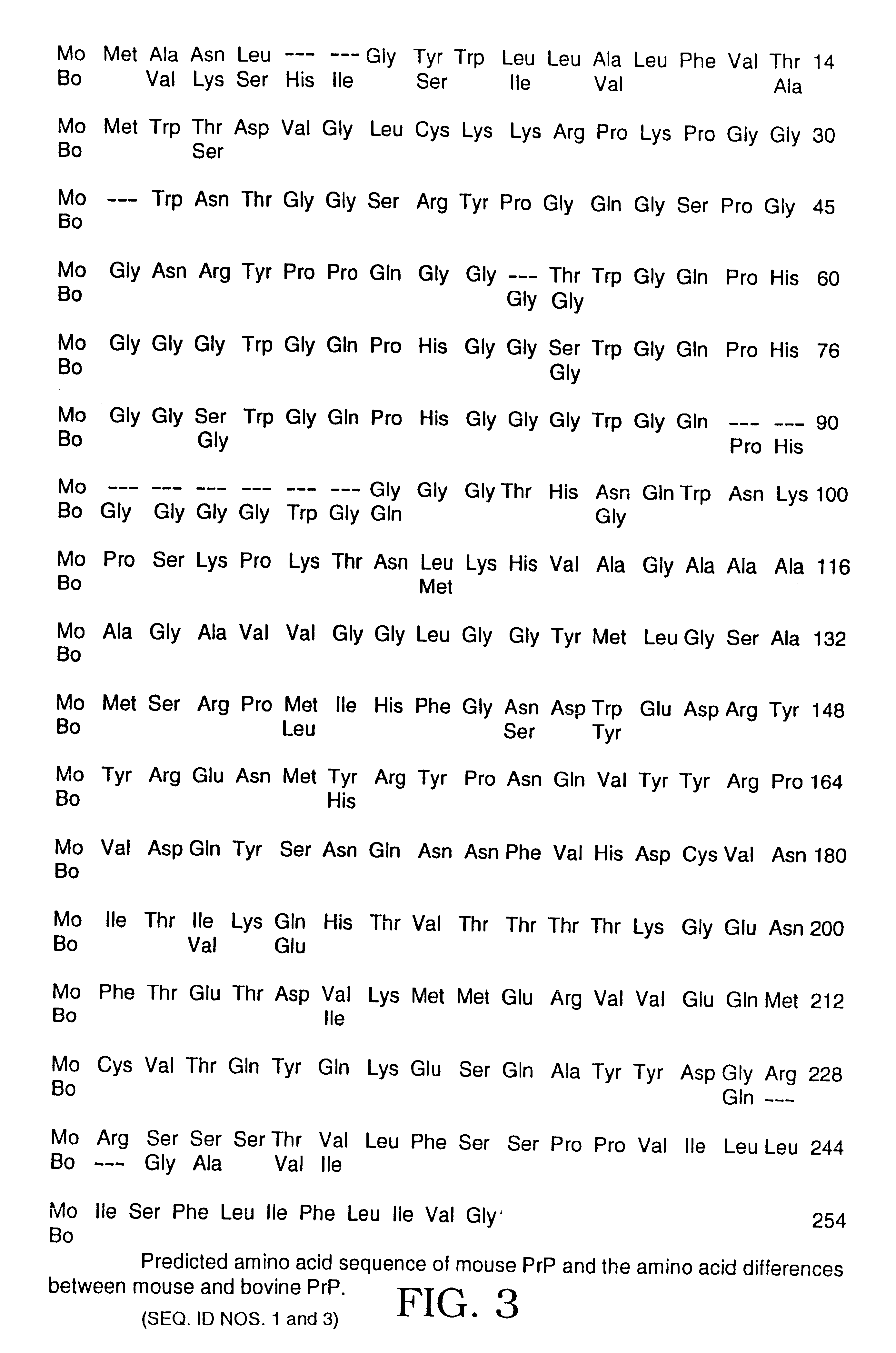Antibodies specific for native PrPSc
a technology of antibodies and prions, applied in the field of antibodies specific for native prions, can solve the problems of limiting the amount of antibodies which might be generated, reducing the ability to find antibodies, and difficult to produce antibodies which bind to certain proteins, so as to neutralize the infectivity of naturally occurring prions, the effect of efficient and cost-effective assays
- Summary
- Abstract
- Description
- Claims
- Application Information
AI Technical Summary
Benefits of technology
Problems solved by technology
Method used
Image
Examples
examples 14-18
below and specifically Example 17 show the isolation of an antibody which specifically binds to PrP.sup.Sc without any denaturation. A sample containing PrP proteins (i.e., PrP.sup.C and PrP.sup.Sc) can be subjected to denaturation by the use of protease K (PK) digestion. The use of such will digest PrP.sup.C but not PrP.sup.Sc. Thus, after carrying out the digestion the sample is contacted with the antibody (e.g., R2) as per Example 17 under suitable binding conditions. Preferably, the antibody is bound to a substrate and can be positioned such that the sample can be easily contacted with the substrate material having the antibody bound thereon. If material binds to the antibodies on the substrate the presence of infectious PrP.sup.Sc is confirmed.
In commercial embodiments of the invention it may be desirable to use antibodies of the invention in a sandwich type assay. More particularly, the antibody of the invention may be bound to a substrate support surface. The sample to be tes...
example 1
Purification of MoPrP 27-30
Purified MoPrP 27-30 rods were prepared from the brains of clinically ill CD-1 mice inoculated with RML prions (Chandler scrapie isolate (Chandler R. L. 1961 Lancet, 1378-1379)). Prion rods were recovered from sucrose gradient fractions as previously described (Prusiner, McKinley 1983 Cell). Briefly, the fractions containing prion rods, which sediment in 48-60% (wt / vol) sucrose, were diluted 2:1 in distilled water and centrifuged at 100,000.times.g for 6 h at 4.degree. C. The pellet was resuspended in water, centrifuged again, and the rods resuspended at 1 mg / ml in Ca / Mg-free phosphate buffered saline (PBS) containing 0.2% Sarcosyl. PrP 27-30 was the major protein as determined by SDS-PAGE and silver staining analysis. Protein quantitation was performed by bicinchonic acid dye binding, with a known amount of bovine serum albumin as the protein concentration standard.
example 2
Immunization of Prnp.sup.0 / 0 Mice
Prnp.sup.0 / 0 mice, in which both alleles of the PrP gene (Prnp) is ablated, were immunized with the purified MoPrP 27-30 rods, which were isolated as described in Example 1. Prnp.sup.0 / 0 mice and methods for making this strain are well known in the art (Bueler, et al. 1992). Prnp.sup.0 / 0 mice, which are indistinguishable from normal mice in their development and behavior, are resistant to scrapie following intracerebral inoculation of infectious MoPrP.sup.Sc (Bueler, et al. 1993 Cell; Prusiner et al. PNAS 1993), and will develop IgG serum titers against Mo--, SHa, and human PrP following immunization with relatively small quantities of purified SHaPrP 27-30 in adjuvant (Prusiner et al. PNAS 1993).
Three (3) six week old Prnp.sup.0 / 0 mice were immunized by intraperitoneal injection of 100 .mu.g of MoPrP 27-30 rods fully emulsified in complete Freund's adjuvant. Subsequently mice were boosted 2 times at 2-week intervals with incomplete Freund's adjuvant...
PUM
| Property | Measurement | Unit |
|---|---|---|
| body weight | aaaaa | aaaaa |
| time | aaaaa | aaaaa |
| concentration | aaaaa | aaaaa |
Abstract
Description
Claims
Application Information
 Login to View More
Login to View More - R&D
- Intellectual Property
- Life Sciences
- Materials
- Tech Scout
- Unparalleled Data Quality
- Higher Quality Content
- 60% Fewer Hallucinations
Browse by: Latest US Patents, China's latest patents, Technical Efficacy Thesaurus, Application Domain, Technology Topic, Popular Technical Reports.
© 2025 PatSnap. All rights reserved.Legal|Privacy policy|Modern Slavery Act Transparency Statement|Sitemap|About US| Contact US: help@patsnap.com



